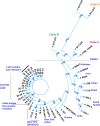Candida auris Pan-Drug-Resistant to Four Classes of Antifungal Agents
- PMID: 35770999
- PMCID: PMC9295560
- DOI: 10.1128/aac.00053-22
Candida auris Pan-Drug-Resistant to Four Classes of Antifungal Agents
Abstract
Candida auris is an urgent antimicrobial resistance threat due to its global emergence, high mortality, and persistent transmissions. Nearly half of C. auris clinical and surveillance cases in the United States are from the New York and New Jersey Metropolitan area. We performed genome, and drug-resistance analysis of C. auris isolates from a patient who underwent multi-visceral transplantation. Whole-genome comparisons of 19 isolates, collected over 72 days, revealed closed similarity (Average Nucleotide Identity > 0.9996; Aligned Percentage > 0.9764) and a distinct subcluster of NY C. auris South Asia Clade I. All isolates had azole-linked resistance in ERG11(K143R) and CDR1(V704L). Echinocandin resistance first appeared with FKS1(S639Y) mutation and then a unique FKS1(F635C) mutation. Flucytosine-resistant isolates had mutations in FCY1, FUR1, and ADE17. Two pan-drug-resistant C. auris isolates had uracil phosphoribosyltransferase deletion (FUR1[1Δ33]) and the elimination of FUR1 expression, confirmed by a qPCR test developed in this study. Besides ERG11 mutations, four amphotericin B-resistant isolates showed no distinct nonsynonymous variants suggesting unknown genetic elements driving the resistance. Pan-drug-resistant C. auris isolates were not susceptible to two-drug antifungal combinations tested by checkerboard, Etest, and time-kill methods. The fungal population pattern, discerned from SNP phylogenetic analysis, was consistent with in-hospital or inpatient evolution of C. auris isolates circulating locally and not indicative of a recent introduction from elsewhere. The emergence of pan-drug-resistance to four major classes of antifungals in C. auris is alarming. Patients at high risk for drug-resistant C. auris might require novel therapeutic strategies and targeted pre-and/or posttransplant surveillance.
Keywords: Candida auris; New York; amphotericin B; antifungal combination; caspofungin; echinocandins; fluconazole; flucytosine; gene deletion; gene mutation; multidrug-resistant; pan-drug-resistant; real-time PCR; transplant patient; whole-genome sequencing.
Conflict of interest statement
The authors declare no conflict of interest.
Figures




References
-
- CDC. 2019. Antibiotic resistance threats in the United States. U.S. Department of Health and Human Services, CDC, Atlanta, GA. https://www.cdc.gov/drugresistance/biggest-threats.html.
-
- Chow NA, Gade L, Tsay SV, Forsberg K, Greenko JA, Southwick KL, Barrett PM, Kerins JL, Lockhart SR, Chiller TM, Litvintseva AP, US Candida auris Investigation Team . 2018. Multiple introductions and subsequent transmission of multidrug-resistant Candida auris in the USA: a molecular epidemiological survey. Lancet Infect Dis 18:1377–1384. 10.1016/S1473-3099(18)30597-8. - DOI - PMC - PubMed
-
- Eyre DW, Sheppard AE, Madder H, Moir I, Moroney R, Quan TP, Griffiths D, George S, Butcher L, Morgan M, Newnham R, Sunderland M, Clarke T, Foster D, Hoffman P, Borman AM, Johnson EM, Moore G, Brown CS, Walker AS, Peto TEA, Crook DW, Jeffery KJM. 2018. A Candida auris outbreak and its control in an intensive care setting. N Engl J Med 379:1322–1331. 10.1056/NEJMoa1714373. - DOI - PubMed
-
- Lockhart SR, Etienne KA, Vallabhaneni S, Farooqi J, Chowdhary A, Govender NP, Colombo AL, Calvo B, Cuomo CA, Desjardins CA, Berkow EL, Castanheira M, Magobo RE, Jabeen K, Asghar RJ, Meis JF, Jackson B, Chiller T, Litvintseva AP. 2017. Simultaneous emergence of multidrug-resistant Candida auris on 3 continents confirmed by whole-genome sequencing and epidemiological analyses. Clin Infect Dis 64:134–140. 10.1093/cid/ciw691. - DOI - PMC - PubMed
Publication types
MeSH terms
Substances
Grants and funding
LinkOut - more resources
Full Text Sources
Molecular Biology Databases

